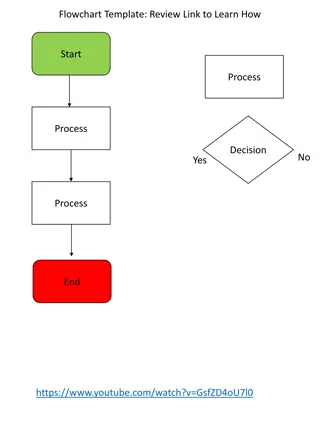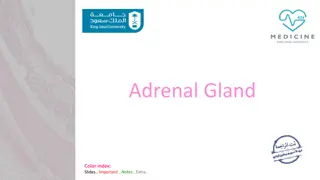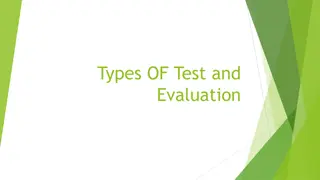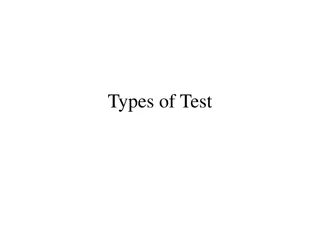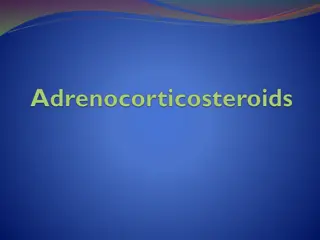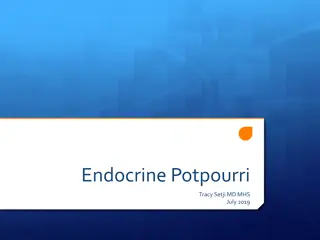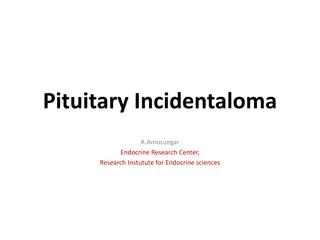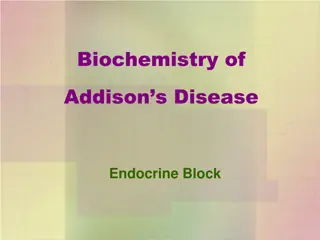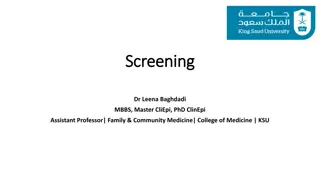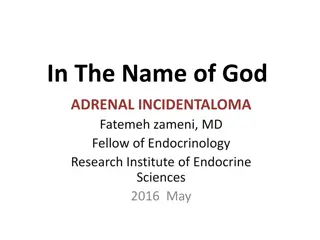Recommended Screening Tests in Adrenal Incidentalomas
This information outlines recommended screening tests for adrenal incidentalomas, additional analyses for bilateral incidentalomas, and details on primary aldosteronism, Conns syndrome, and a case study of a woman with primary aldosteronism. The content covers screening tests for various conditions associated with adrenal incidentalomas, such as Cushing's syndrome, pheochromocytoma, and primary aldosteronism. It also provides insights into additional analyses required for bilateral incidentalomas based on clinical presentation and family history. The case study highlights the successful treatment of a 62-year-old woman with a history of right adrenal aldosterone-producing adenoma. The recommended tests and treatments are essential for managing adrenal incidentalomas effectively.
Download Presentation

Please find below an Image/Link to download the presentation.
The content on the website is provided AS IS for your information and personal use only. It may not be sold, licensed, or shared on other websites without obtaining consent from the author.If you encounter any issues during the download, it is possible that the publisher has removed the file from their server.
You are allowed to download the files provided on this website for personal or commercial use, subject to the condition that they are used lawfully. All files are the property of their respective owners.
The content on the website is provided AS IS for your information and personal use only. It may not be sold, licensed, or shared on other websites without obtaining consent from the author.
E N D
Presentation Transcript
Table 1 Recommended screening tests in adrenal incidentalomas. Additional analyses in bilateral incidentalomas listed below will depend on the clinical presentation and family history.
Recommended screening for all incidentalomas Test 1 mg overnight dexamethasone suppression test 24-hour urine collection for fractionated metanephrines and catecholamines Cushing's syndrome Pheochromocytoma Primary aldosteronism (screen only in hypertensive patients) Plasma aldosterone to plasma renin activity ratio
screening recommended for bilateral incidentalomas Test Adrenal insufficiency Morning cortisol and ACTH (or corticotrophin stimulation test) RET gene mutation analysis, evaluation for hyperparathyroidism, medullary thyroid cancer, or mucosal neuromas MEN2 Von Hippel-Lindau syndrome VHL gene mutation analysis and evaluation for additional tumors (such as renal, retinal, or nervous system) Neurofibromatosis type 1 Pheochromocytoma- paraganglioma syndrome NF1 gene mutation analysis SDHB/SDHD gene mutation analysis
Conns syndrome (adrenal aldosterone- producing adenoma) and bilateral adrenal hyperplasia are the most common causes of primary aldosteronism. The treatment of choice for patients with aldosterone-producing adenoma is unilateral total adrenalectomy. Recurrence after adequate surgery is exceptional.
A 62-year-old woman was admitted to the hospital because of severe hypokalemia and poorly controlled hypertension. She underwent adenomectomy for primary aldosteronism due to right APA 9 years ago. The pathological examination revealed a 2-cm diameter ad- enoma without other abnormalities. After surgery, she had been asymptomatic with normotension and normokalemia without pharmacologic treatment
In the follow-up repeated plasma renin activity and serum aldosterone levels were normal. Six months before admission, hypertension resistant to antihypertensive poly therapy, weakness and paraesthesias developed. At entry, her medications comprised fosinopril (20 mg daily),amlodipine (10 mg daily) and hydrochloro- iazide (25 mg daily). There was no family history of hypertension.
A physical examination showed only moderate obesity. The blood pressure was 160/110 mmHg. Blood chemistry showed: urea 4.3 nmol/l, creatinine 52 mol/l, sodium 143 mmol/l, potassium 2.4 mmol/l and chloride 96 mmol/l. Haematology, chest X-ray and electrocardiogram were normal.
On free dietary sodium intake, measured supine at 08.00 h before she arose, plasma aldosterone concentration was3575 pmol/l (normal range 41 412 pmol/l)and plasma renin activity was undetectable.Upright at 08.00 h, plasma aldosterone con- centration and plasma renin activity were 2550pmol/l (137 825 pmol/l) and undetectable,respectively. Plasma aldosterone concentration before and after saline loading was 3230 pmol/land 3055 pmol/l, respectively.
The 24-hour urinary free cortisol was 120 nmol (75 250nmol). The 08.00 h basal cortisol was 223nmol/l (140 690 nmol/l). The 08.00 h cortisol after dexamethasone suppression (1 mg at23.00 h) was 47 nmol/l. The 24-hour urinary free catecholamines, dopamine, epinephrine and norepinephrine were normal.
Adrenal adenomas can be differentiated from metastases by adrenal MRI. A hyperintense rim in T1- andT2-weighted sequences is characteristic for adenomas,as in our case.
We describe the recurrence of an adrenal APA 9 years after adenomectomy, which is extremely rare; to our knowledge, only two such cases have previously been reported in the literature.
The resected adrenal gland sometimes contains macro- or micro-nodular lesions in addition to APA.These nodules are multiple and generally bilateral and lead to a more complex diffrential diagnosis than the presence of a unilateral solitary mass. This bilateral nodularity is not synonymous with hyperplasia, and adrenal venous sampling is required to detect cases of surgically correctable APA.The clinical significance of these nodular lesions in patients with APA is not fully clear. They are not thought to contribute to recurrence but to result from intractable hypertension.
Autopsy studies suggest a prevalence of incidentalomas of around 2% (range 1.0 8.7%), increasing with age. Radiological studies report a frequency close to 3% in patients below the age of 50 years, increasing up to 10% in the elderly. Childhood incidentalomas are extremely rare.
Rationale Bilateral adrenal masses usually represent benign adenomas, macronodular hyperplasia or distinct bilateral nodules. In the relevant clinical setting, metastases (especially in patients with known malignancy), lymphoma or pheochromocytomas should also be considered. Each lesion should be evaluated individually as bilateral adrenal masses can represent co-occurrence of different lesions.
IMPORTANCE Adrenal incidentalomas are found in 1% to 5% of abdominal cross-sectional imaging studies. Although the workup and management of unilateral lesions are well established, limited information exists for bilateral incidentalomas.OBJECTIVETo compare the natural history of patients having bilateral incidentalomas with those having unilateral incidentalomas.DESIGN, SETTING, AND PARTICIPANTS Retrospective analysis of a prospective database of consecutive patients referred to an academic multidisciplinary adrenal conference. The setting was a tertiary care university hospital among a cohort of 500 patients with adrenal lesions between July 1, 2009, and July 1, 2014
RESULTS 23 patients with bilateral incidentalomas and 112 patients with unilateral lincidentalomas were identified. The mean age at diagnosis of bilateral lesions was 58.7 years.The mean lesion size was 2.4 cm on the right side and 2.8 cm on the left side. Bilateral incidentalomas were associated with a significantly higher prevalence of subclinical Cushing syndrome (21.7%[5 of 23] vs 6.2%[7 of 112]) (P = .009) and a significantly lower prevalence of pheochromocytoma (4.3%[1 of 23] vs 19.6%[22 of 112]) (P = .003) compared with unilateral lesions, while rates of hyperaldosteronism were similar in both groups (4.3%[1 of23] vs 5.4%[6 of 112]) (P > .99). Only one patient with bilateral incidentalomas underwent unilateral resection. The mean follow-up was 4 years (range, 1.2-13.0 years). There were no occult adrenocortical carcinomas.
Abstract A 50-year-old male patient with a 15-year history of hypertension was referred to our hospital for evaluation of bilateral adrenal tumors. No Cushingoid features were observed. Computed tomographic scan showed 10-mm masses in each adrenal gland. Preoperative endocrinological examinations revealed autonomous cortisol and aldosterone secretion in this patient. The results of a subsequent adrenal venous catheterization study were consistent with the presence of a left cortisol-producing tumor and a right aldosterone-producing tumor. A left partial adrenalectomy was performed initially, but cortisol and aldosterone over-secretion persisted. Accordingly, the patient underwent a right adrenalectomy. Pathological examination of the resected specimens, including immunohistochemical analysis, demonstrated that both adenomas possibly produced cortisol and aldosterone. This is an extremely rare case of bilateral adrenal tumors, in which the left adrenocortical tumor produced and secreted cortisol or both cortisol and aldosterone and the right one produced and secreted both aldosterone and cortisol, as confirmed by clinical findings and pathological studies using immunohistochemical analysis.
Approximately 15% of adrenal incidentalomas occur bilaterally . Whereas most unilateral masses are benign or nonfunctional, the bilateral adrenal mass is more likely metastatic disease, hemorrhage, infiltrative disease, congenital adrenal hyperplasia, macronodular Cushing's syndrome, or bilateral cortical adenomas . A Bilaterl pheochromocytomas are also possible, especially as part of a familial syndrome.
Primary bilateral macronodular adrenal hyperplasia is a rare cause of Cushing's syndrome and is more often diagnosed as bilateral adrenal incidentalomas with subclinical cortisol production.


